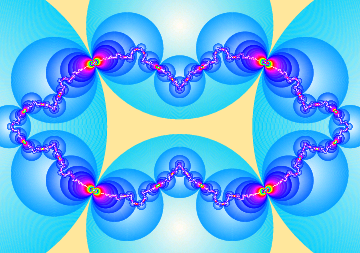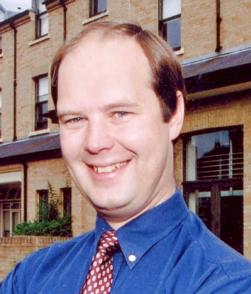
Maths goes public
I was Editor of Plus from 1999 to 2002, a fantastically exciting time to be involved with the public understanding of mathematics and the development of the Internet as a tool for reaching huge numbers of people worldwide, something that simply had not been possible a few years earlier. I took over from Dr Robert Harding, who in the last edition described how in 1996 he founded PASS Maths (as it was then known). He had been hugely successful in creating a vibrant online magazine and had published 6 issues, the first in January 1997 and his final one in September 1998. My task was to continue and build on that strong beginning.

The Centre for Mathematical Sciences in Cambridge, home of Plus.
What changes have there been in the public understanding of mathematics, and of science more generally, since 2002? Firstly, there seems to be much more "public understanding" around — newspapers, television and traditional magazines seem to have more and better coverage of scientific issues than ever before nowadays. That is great, of course, but often mathematical aspects are dumbed down in media reports because the media assumes that real maths is just too hard for the public to grasp. They usually turn anything mathematical into a childish "gee-whiz" story instead. At Plus we have always assumed that our audience is made of sterner stuff: our articles have equations and real mathematical content. We know that not all our readers will understand all the equations, but we trust that you want to be challenged and intrigued by what we have to tell you.
The other big change that I've observed is in the outreach work being done by pure mathematicians. Applied mathematicians are the people who are most closely associated with maths as it is used in the real world, so they often get top billing when talking to the general public. But in the last few years pure mathematicians have got much better at explaining what they do, why it is interesting, exciting and intriguing, and why it is relevant (even though pure maths is usually regarded as totally abstract). So we have topologists explaining how knot theory is important in understanding genetics (because DNA is knotted), number theorists explaining why prime numbers are all-important whenever you access a secure website (because modern cryptography relies on the properties of prime numbers), and so on. Plus is on a mission to help pure mathematicians reach out to the general public.
Something I did early on as Editor was to change the name of the magazine (the first issue of Plus proper was in January 2000). The original name, PASS Maths (short for Public Awareness and Schools Support for Mathematics), was a good acronym but made the magazine sound like something to help you pass your Maths GCSE. We needed a name that indicated that the magazine was about mathematics, but also indicated that it was about more than passing exams. "Plus" sounded just right to us, even though we discovered that some other people had already used the name before us (for instance, plusmagazine.nl and, I believe, the London Mathematical Society). Everybody we asked seemed to agree with our choice, so Plus it was.

More or less simultaneous with the name change was the incorporation of Plus into the fledgling Millennium Mathematics Project (or MMP as it is known here). At the time we felt rather over-shadowed by NRICH, the other main branch of the MMP: it had been around longer, had a much greater readership, had been mentioned in the National Numeracy Strategy and didn't have to beg authors for articles like we did. But, importantly, the MMP's remit was to pay equal attention both to schools and to public understanding: so NRICH and Plus were equally important in the eyes of the MMP. That trust has since been repaid handsomely: Plus and NRICH now have very similar numbers of readers and Plus is just as well-known.
The highlight of my time as Editor of Plus was, no doubt, winning a Webby for Best Science Site on the Web. I went to San Francisco in July 2001 to receive the award, but when I went I had no idea that we would win: we were just one of five nominees. The other four nominees were all absolutely fantastic sites (and they're still going strong) so it was a real honour (and a shock!) to win. I had never heard of the person hosting the Webby award ceremony, Sam Donaldson, even though everybody else seemed to be in awe of him. He was apparently a famous American news-reader. But to be in the same company as the winners of other categories, which included the The BBC World Service, Yahoo, Expedia and Google, was a real accolade.

Robert Hunt with the Webby.
One of the huge strengths of Plus is that it is published by a real mathematics department in a real university (the Faculty of Mathematics at Cambridge University). It isn't written by people who only enjoy mathematical games and puzzles, or by school teachers writing for school children, but by real mathematicians: and that means that many articles in Plus are about how real mathematicians use real mathematics in their research. It was always important to us to publish articles that explained why maths is relevant to the real world, rather than just being an abstract subject designed to confuse school children trying to learn algebra or trigonometry. So during my time on the magazine we had articles on gyroscopes, mobile phones, mathematical art, music, compound interest, the Cuban missile crisis, the spread of disease, the size of the Milky Way, financial trading, and the design of toilet paper. And that's only a fraction of the articles — quite a variety!
Although Plus is read world-wide, we are based in the UK, and have an unashamedly British editorial stance. (We sometimes get asked why we spell "maths" with an "s" at the end!) Something that has therefore been important to us is the number of people studying maths at UK schools and subsequently at University. When Plus began, there was a real worry about the number of students taking maths A-levels; it had been falling continually for several years and university maths departments appeared to be in terminal decline. Thankfully, things seem much better now. In the past few years, more and more sixth-formers have been choosing maths A-levels, in part because of attractive syllabus changes, but also because of a growing realisation amongst school-teachers and university admissions officers that good mathematical skills really are a prerequisite to studying science at University: physics, chemistry, modern biology and even economics are practically impossible at degree level without a good mathematical grounding.
The career interviews have also been a very important part of Plus in my mind. Not only do they show students studying maths A-level how useful their studies might be to their future careers, but they show everybody how important maths is to our lives in a technological and scientific first-world country. We all encounter mathematics — probably without even realising it — every day of our lives in one way or another, perhaps by just switching on the TV. (The idea of the internals of a TV being designed by somebody who can't use equations is just impossible, whether it's an old-style cathode ray tube (CRT) or a modern plasma or LCD screen! Few people realise this.) Take a look at the huge range of people we’ve interviewed in all sorts of jobs and you’ll see what I mean.

With more bandwidth it's possible to include amazing mathematical imagery. This image is from this issue's article Non-Euclidean geometry and Indra's pearls.
It's strange to think back now to the limitations of the Internet in 1999. We always made sure that Plus articles had lots of pictures, because it made them more interesting and attractive to read: we were aware that graphic design was key to getting people to read our articles and knew that we were competing with other websites. But we were very worried about how big the image files were: in those days, if the pictures were too big or at too high a resolution then the web page would take too long to download and people might give up. Nowadays people have such good, fast connections to the Internet that pages download in a flash. (It helps that the Plus servers are much more powerful now as well!) As time went on we realised more and more the importance of good graphic design so gave the whole site a make-over. A website full of plain text won't be read by anybody (or hardly anybody): it needs to be visually exciting.
In 2002 I handed over the reins of editorship of Plus to Helen Joyce, a pure mathematician who was already working with the Millennium Mathematics Project running MOTIVATE. She took the magazine from strength to strength, increasing the readership base hugely, improving the website's navigation and graphics, and introducing an email subscription service for updates — and, most importantly, persuading more and more inspiring writers to pen articles. I myself moved on to a post at the Isaac Newton Institute for Mathematical Sciences, but couldn't bear to leave such a fantastic resource as Plus and the MMP behind completely — I took the nominal role of Executive Editor of Plus and still give many public lectures and take part in other activities for the MMP.
So Happy Birthday to Plus, still the leading magazine (either online or offline) about mathematics and its applications in the world. Here's to the next ten years!
About the author

Dr Robert Hunt is a Lecturer in the Department of Applied Mathematics and Theoretical Physics at the University of Cambridge, and is a Fellow of Christ's College. He is also the Deputy Director of the Isaac Newton Institute for Mathematical Sciences.